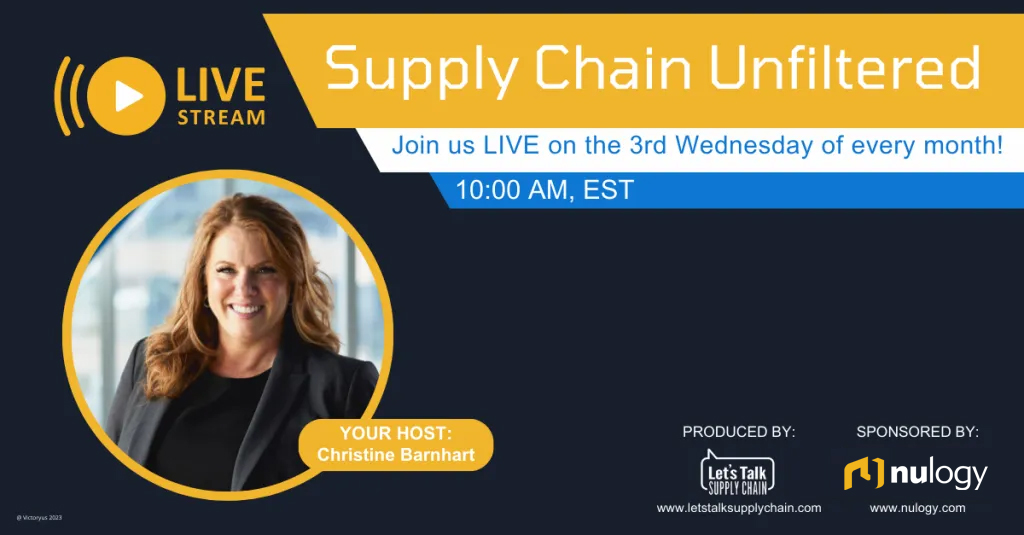Nulogy
Supply Chain Dive
Playbook: Materials Management
Working Title:
Waste Not: Solving Materials Management Challenges in the External Supply Chain
Note: Pull quotes highlighted in yellow.
Between economic downturns and supply chain disruptions due to geopolitical upheaval, it is becoming ever more challenging for fast-moving consumer goods (FMCG) companies to maintain a timely view of their external supply chain activities. And, while many areas of supply chain management have enjoyed technological modernization efforts, the critical function of managing the purchasing, shipping, and consumption of materials across the external supply chain is often too technologically immature to keep up with the fast pace of today’s market.
Case in point: in a late 2022 survey, 80% of supply chain executives said they struggled with digitally tracking the movement of materials through their supply chains. Additionally, a 2024 Supply Chain Insights survey of contract manufacturing leaders identified “Supplier Visibility” as having the largest gap between operational performance and organizational importance.
Lack of data visibility into materials management across the external supply chain can have serious ramifications for both FMCG enterprises as well as their external partners such as contract packagers and manufacturers—especially in the areas of profitability and customer relationships. The inability to access material-related data quickly, combined with short order lead times and sudden order adjustments, leave little room for corrective action when it is needed the most.
To combat these challenges and successfully navigate the disruptive forces in today’s supply chain world, it is imperative to leverage technologically mature material management capabilities throughout the external supply chain, supported by real-time visibility and predictive tools.
In this playbook, we will discuss the challenges associated with managing materials in the external supply chain, as well as recommended solutions.
The Price You Pay For Inefficient Material Management
A slew of problems can arise from an organization’s inability to efficiently manage the movement of materials through the external supply chain. On one hand, purchasing or storing an excess of materials can clog up valuable warehouse space, which increases carrying costs and—if the materials aren’t consumed in time—physical waste due to expiry or obsolescence.
Conversely, not ordering enough materials ahead of time will leave contract manufacturers and co-packers scrambling at the last minute to correct materials shortages, potentially resulting in financially damaging production delays, wasted time, or expedited shipping costs. External partners will also suffer from additional production and labor costs due to line downtime, as well as adding unpredictability to their order forecasting and planning.
Issues due to inefficient materials management will ultimately end up at the doorstep of retail customers. Large retailers can charge fines as high as 40% of order cost—even if only one item is missing from the order—due to failure to meet OTIF requirements. To add insult to injury, these setbacks will inevitably prompt the retailer to hand your competitor the shelf space that was meant for your products.
It is evident that FMCG companies and their external partners alike will suffer from poor materials management across the external supply chain. With all these expenses and risks in mind, why don’t organizations focus more on optimizing their materials visibility and management?
Roadblocks to Improving Materials Management
A number of issues can affect an organization’s ability to effectively manage the movement of materials through the external supply chain. These issues include:
Constant firefighting that limits time for proactive planning. In a fast-paced industry such as contract packaging and manufacturing, just getting through day-to-day tasks can feel like a perpetual whirlwind. Every day brings with it multiple urgent issues and tasks, and it’s all too easy to get caught up in putting out individual fires without leaving time to proactively plan for the long term. Planners and managers may not have enough time or personnel to explore continuous improvement initiatives or new technologies.
The need to collaborate with multiple departments and stakeholders. Materials management issues can be tricky to solve due to the various internal departments, suppliers, and vendors that have to work together to order and move materials efficiently. Your own organization may be great at handling data, but if vendors, suppliers or customers are lagging behind on technology, it will be common to run into communication issues that result in delays.
For FMCG companies and their co-packing and contract manufacturing partners alike, coordinating with customers and vendors is already a lot to juggle, especially if one or multiple partners can’t share data effectively. This problem is compounded when suppliers and partners use different systems and have different levels of data sophistication and different quality standards for their data. This challenge affects many supply chain executives, with 76% in the 2022 survey citing siloed data as one of their biggest challenges.
Costs associated with onboarding new solutions to solve materials management challenges. Any successful business will be cautious of costs, and the up-front investment in a new technology solution can be met with skepticism or outright aversion. In addition to the financial cost of the solution, organizations also have to devote employee time to researching and vetting tools, implementing them, and training staff to take on new systems and processes.
The Critical Role of Data in Materials Management
The key to evolving materials management in the external supply chain revolves around one simple word: data. In current times, when external supply chains are commonly structured as multi-tiered networks of suppliers, vendors, and customers instead of linear nodes, it is critical for both FMCG enterprises as well as their contract manufacturing and co-packing partners to have real-time data visibility between each other as well as their suppliers and vendors.
By implementing a purpose-built solution to enable this new level of data visibility, each party can gain an up-to-date view of the purchasing, movement, and consumption of the materials needed to fulfill orders on time and in full, while maximizing budget spend and production efficiency.
“When organizations have inefficient material processes, it often comes down to segmented data, which leads to suboptimal decisions.” – Emily Shepherd, Senior Product Manager, Nulogy
For instance, here are three areas in which a purpose-built materials management solution can directly impact materials management processes in the external supply chain:
Current inventory, materials in transit and materials needed. A materials management solution can provide a centralized, up-to-date “dashboard” of current inventory levels, including stock held in multiple locations. This automated view can also factor in demand, using either a forecast model or historical order data from customers to determine which components are needed in which amounts to fulfill orders on time and in full. This dashboard can also factor in materials in transit that have already been ordered, further streamlining the decision-making process.
Vendor ordering details. FMCGs and their external supply chain providers commonly work with a multitude of vendors, in addition to sourcing vendors for future orders. These vendors commonly vary in provided lead times, as well as minimum order quantities and minimum order increments. Instead of manually calculating these lead times and order quantities by vendor, an automated solution can calculate order costs and quantities based on the vendor information provided, and can even go as far as track reject rates for each vendor. Having an automated, comprehensive view of vendor information enables teams to make smarter purchasing decisions to ensure production lines have what they need, when they need it.
Vendor pricing levels. Additionally, many vendors have different pricing levels based on order volume. By having a solution that can automatically calculate these pricing levels when ordering new materials, companies can save money by ordering in larger quantities, especially for materials that are used regularly. Keeping a safety stock of those materials can give the best of both worlds: minimizing your risk of running out, and better pricing.
Consolidating all the data points needed to paint a complete picture of the materials management flow in the external supply chain—namely, materials needed vs. materials on hand or in transit—can offer FMCG companies and their external supply chain partners a significant boost in overall fulfillment efficiency and attainment. Efficient data handling and efficient materials handling are intertwined: materials simply cannot be managed properly without good data.
3 Steps to Choosing a Materials Management Solution
A homegrown solution or manual-based processes such as spreadsheets may work for your organization in the short term. As your business grows, however, so will the complexity (and chaos) of trying to manage your materials movement using outdated tools and solutions. Organizations with a focus on long-term growth require a modern solution that provides clarity through consolidated, high-fidelity data.
If you’re frustrated by your current manual processes when it comes to materials management, and you’re ready to make an investment in a purpose-built solution, your next step is to understand the capabilities offered in the market and match them to your needs. The software you select should help consolidate the materials management data you work with on a daily basis, and provide timely recommendations and calculations to effectively order and track the materials needed for future and upcoming orders.
To that end, here are three recommendations to consider:
1. Look for a solution that enables data visibility between your organization and your external supply chain partners for greater collaboration. Cutting down the blind spots between organizations has a dramatic effect on your materials order and tracking capabilities. An effective solution will allow you to consolidate data from multiple sources for a much clearer picture of your current and forecasted orders.
2. Choose a software vendor with a proven track record in the industry. The last thing you want to do is make a costly investment in a provider that fails to understand the complexities of contract manufacturing and co-packing. Look for case studies that illustrate how the software worked in a real-world production environment.
3. Ensure that the software solution easily future-proofs your organization. Many software vendors offer extensively customizable solutions that can balloon in implementation costs, or require continual maintenance sessions which can incur hidden costs over time and lack scalability as your business grows. The ideal software solution should be built upon a cloud-based subscription model that not only ensures costs are consistent and transparent, but also ensures that the solution will be continually updated and scalable as your business grows.
The results you can achieve from investing in better technology will have a dramatic effect on your organization’s overall ability to meet customer demand and deliver on time, in full every time. It can also bolster collaboration between you and your external supply chain partners, with a central source of data “truth” that gets everyone on the same page and pulling in the same direction to achieve shared success.
This ability to better communicate and more accurately plan materials orders will minimize or eliminate production delays. You’ll waste fewer materials and bring down labor costs associated with workers waiting for production to resume after materials run out.
Evolve Your Materials Management Processes Today
Effective materials ordering and tracking functions can have outsized benefits for your organization as well as the customers, vendors, and suppliers you work with across the external supply chain. This paper explored the risks and costs of inefficient materials management, as well as the role that effective data flow and consolidation can play in improving these processes for you and your external supply chain partners.
These benefits can be as simple as saving headaches for your planners, to boosting profitability for your business and bolstering relationships with your suppliers and customers.
It’s not too late to begin evolving your materials management strategy. To learn more, visit Nulogy.com.


